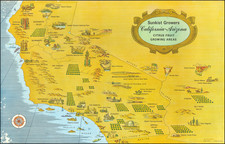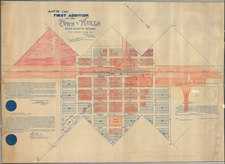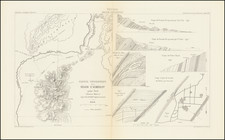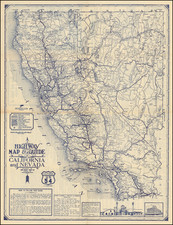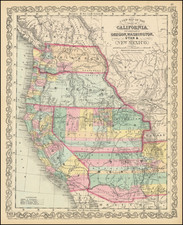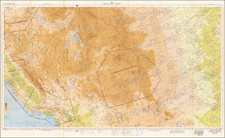A Rare Map of Nevada's Most Famous Ore Lode
Rare contemporary map of the Sutro Tunnel, Comstock Lode, Virginia City, etc. published in San Francisco in 1870 (see the "Yield of Bullion" numbers in the top diagram).
Three separate images are shown on the map. The center image is a map of the surface area around the Comstock Lode, showing the proposed route for the Sutro Tunnel, meant to drain excess water. This was first published in 1866. Two other maps show cross-sections along the proposed tunnel, one focusing on the geology and one on the mining. A note placing the combined value drawn from the Comstock Lode up until April 1870 at 120,000,000 dollars suggests the present chart was published that year or soon after.
Mining continues to fuel a fifth of Nevada's economy, but in the early days of the state as much as a quarter of the population was involved with a single mining operation: the Comstock Lode. The mines in this remote part of western Nevada were producing as much six million dollars worth of silver and gold a single month. Two of the main mines for the Lode were once valued as high as one billion dollars, nearly a quarter trillion adjusted for inflation.
The main period of mining occurred from 1859 to 1874, though the mine was operational into the 1900s. Public interest in the mine was huge, with publications of maps regarding the mine from San Francisco to London. This map would have been produced to satisfy this curiosity, both from investors and from the general public. The topographic map shows the areal extent of each load, as well as the mining cities American City, Virginia City, and Sutro. In addition, land claims are shown along with detailed topography. The cross-sections are particularly unique, with only a few other examples of these being made available to the public. The geological map follows the Sutro Tunnel, showing a cross-section across the main loads and their relations to geology. The geology is mostly comprised of evolved igneous rocks, whose formation during continental volcanic activity is commonly coupled with hydrothermal circulation carrying lithophile incompatible elements, including silver and gold. The position of the Comstock Lode at the boundary between syenite and trachyte (two rocks with the same composition but which formed in very different circumstances) likely allowed for such vast quantities of ore to be deposited, as hydrothermal circulation would have been more continuous at this contact.
The second cross-section was likely of more interest to the lay reader. It follows the proposed "Branch Tunnel," which offshoots from the end of the Sutro Tunnel and lies subparallel to the Comstock Lode. This map shows the many shafts and claims of the area, including the locations where ore has been mined. Notes detail the cumulative yields of different claims, and the cross-section is topped with an attractive view of the surrounding high mountains.
The Comstock Lode
Mining of the Comstock Lode was perhaps the most famous phase in Nevada's mining history. While more ore is being mined today due to refined techniques, no subsequent lodes have so fueled the state's economy and global public interest. The history of the Lode is complete with the many tales of riches, bankruptcies, back-stabbings, engineering feats, all of which may seem more fictional than real to modern readers.
Gold was first discovered in the area by Mormon 49ers while waiting for the snows of the Sierra Nevada to thaw. However, the current focus on California led to the neglect of this discovery, with only some small claims being set up by the end of the decade. Henry Comstock, a veteran of the Californian goldfields, arrived in the area and was hired by the Grosh brothers to manage their claim while they set out west to try to raise funds. After the brothers died while trying to cross the Sierras and hearing about the discovery of silver in the area, Comstock took control of their lands and gained several more through threats and dealings (at one point trading a blind horse and bottle of whiskey for a one-tenth claim). The Lode was struck soon after and named in his honor. All the original owners of the claim sold their shares to corporations that could exploit the Lode more fully. Comstock made a small profit off of the sale, which he invested in a general store, though he eventually went broke and committed suicide.
The operation only grew from 1859 onwards. Surface diggings soon gave way to mining, which presented its own suite of problems. The ore bodies in the Comstock were not pocket rather than vein shaped whose extraction could lead to cave-ins, and so they had to be extracted using new methods. Further developments in extraction, logistics, and processing were made over the course of the history of the mine. Of particular concern was the high level of water flows through the mine, which the Sutro Tunnel was eventually designed to manage.
Interest in the mines declined after the completion of the Sutro Tunnel and production peaking in 1877. Deep exploration continued to 1918, and sporadic shallow mining in the region continues to the present day.
The Sutro Tunnel
Extensive pumping operations and occasional tapping of reservoirs made mining difficult. To combat this, Adam Sutro proposed a simple solution: building a drainage tunnel extending from the Comstock Lode to the low-lying areas near the Carson River, which would provide an outflow for any excess water above the tunnel depth. Branches of the tunnel would run along the Lode, so that all the major mines would be able to release water above the level of the tunnel.
The tunnel was first proposed in 1860, and it gained approval by 1865. Some opposition came from companies and owners who worried about alternate access points to mines, but many local miners were supportive of this project as it would increase mine safety. The tunnel was completed in 1878, though some mines had gone deeper by that point and still required pumping. Gradually, pumping stopped until all water was drained by the tunnel and mining was limited to realms above the tunnel.
After completion of the mine, Sutro moved to San Francisco, became mayor, and built the Sutro Baths using his now extensive knowledge of tunnels.









